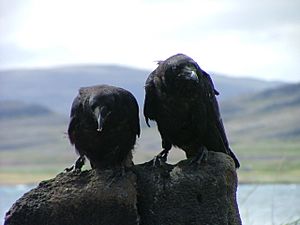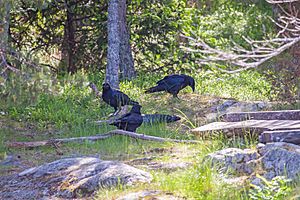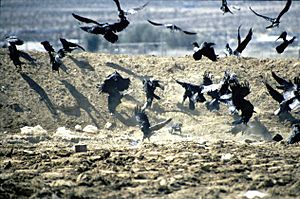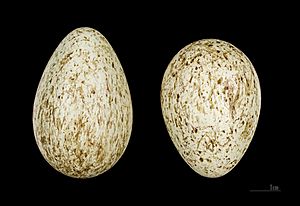Common raven facts for kids
Quick facts for kids Common raven |
|
|---|---|
 |
|
| At Bodega Head State Park, US | |
| Conservation status | |
| Scientific classification | |
| Kingdom: | |
| Class: | |
| Order: | |
| Family: | |
| Genus: | |
| Binomial name | |
| Corvus corax |
|
 |
|
| Common raven range | |
The common raven (Corvus corax), also known as the northern raven, is a large all-black passerine bird. Found across the Northern Hemisphere, it is the most widely distributed of all corvids. There are at least eight subspecies with little variation in appearance, although recent research has demonstrated significant genetic differences among populations from various regions. It is one of the two largest corvids, alongside the thick-billed raven, and is possibly the heaviest passerine bird; at maturity, the common raven averages 63 centimetres (25 inches) in length and 1.2 kilograms (2.6 pounds) in mass. Common ravens can live up to 21 years in the wild, a lifespan surpassed among passerines by only a few Australasian species such as the satin bowerbird and probably the lyrebirds. Young birds may travel in flocks but later mate for life, with each mated pair defending a territory.
Common ravens have coexisted with humans for thousands of years and in some areas have been so numerous that people have regarded them as pests. Part of their success as a species is due to their omnivorous diet; they are extremely versatile and opportunistic in finding sources of nutrition, feeding on carrion, insects, cereal grains, berries, fruit, small animals, and food waste.
Some notable feats of problem-solving provide evidence that the common raven is unusually intelligent. Over the centuries, it has been the subject of mythology, folklore, art, and literature. In many cultures, including the indigenous cultures of Scandinavia, ancient Ireland and Wales, Bhutan, the northwest coast of North America, and Siberia and northeast Asia, the common raven has been revered as a spiritual figure or god.
Contents
Classification
The closest relatives of the common raven are the brown-necked raven (C. ruficollis), the pied crow (C. albus) of Africa, and the Chihuahuan raven (C. cryptoleucus) of the North American southwest. While some authorities recognized as many as 11 subspecies, others only recognize eight:
| Subspecies | Image | Distribution | Notes |
|---|---|---|---|
| C. c. corax |  |
From Europe eastwards to Lake Baikal, south to the Caucasus region and northern Iran | It has a relatively short, arched bill. The population in south-western Europe (including the Balearic Islands, Corsica and Sardinia) has an even more arched bill and shorter wings than "typical" nominate, leading some authorities to recognize it as a separate subspecies, C. c. hispanus. |
| C. c. varius | 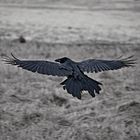 |
Iceland and the Faroe Islands | It is less glossy than C. c. principalis or nominate corax, is intermediate in size, and the bases of its neck feathers are whitish (not visible at a distance). An extinct color morph found only on the Faroes is known as the pied raven. |
| C. c. subcorax |  |
From Greece eastwards to north-west India, Central Asia and western China though not the Himalayan region | It is larger than the nominate form, but has relatively short throat feathers (hackles). Its plumage is generally all black, though its neck and breast have a brownish tone similar to that of the brown-necked raven; this is more evident when the plumage is worn. The bases of its neck feathers, although somewhat variable in colour, are often almost whitish.
The name C. c. laurencei (also spelt lawrencii or laurencii) is sometimes used instead of C. c. subcorax. It is based on the population from Sindh described by Hume in 1873 and is sometimes preferred since the type specimen of subcorax collected by Nikolai Severtzov is possibly a brown-necked raven. The population restricted to the Sindh district of Pakistan and adjoining regions of northwestern India is sometimes known as the Punjab Raven. |
| C. c. tingitanus |  |
North Africa and the Canary Islands | It is the smallest subspecies, with the shortest throat hackles and a distinctly oily plumage gloss. Its bill is short but markedly stout, and the culmen is strongly arched. Canary Islands ravens are browner than the North African ravens, leading some authorities to treat them as separate subspecies, with the latter maintaining the name C. c. tingitanus and the former known as C. c. canariensis. |
| C. c. tibetanus |  |
Himalayas | It is the largest and glossiest subspecies, with the longest throat hackles. Its bill is large but less imposing than that of C. c. principalis, and the bases of its neck feathers are grey. |
| C. c. kamtschaticus |  |
North-eastern Asia | Intergrades into the nominate subspecies in the Baikal region. It is intermediate in size between C. c. principalis and C. c. corax and has a distinctly larger and thicker bill than does the nominate race. |
| C. c. principalis |  |
Northern North America and Greenland | It has a large body and the largest bill, its plumage is strongly glossed, and its throat hackles are well developed. |
| C. c. sinuatus, the western raven |  |
South-central USA and Central America. | It is smaller, with a smaller and narrower bill than C. c. principalis. Populations in far south-western USA and north-western Mexico (including the Revillagigedo Islands) are the smallest in North America. They are sometimes included in C. c. sinuatus, while other authorities recognize them as a distinct subspecies, C. c. clarionensis. |
Evolutionary history
The common raven evolved in the Old World and crossed the Bering land bridge into North America. Recent genetic studies, which examined the DNA of common ravens from across the world, have determined that the birds fall into at least two clades: a California clade, found only in the southwestern United States, and a Holarctic clade, found across the rest of the Northern Hemisphere. Birds from both clades look alike, but the groups are genetically distinct and began to diverge about two million years ago.
The findings indicate that based on mitochondrial DNA, common ravens from the rest of the United States are more closely related to those in Europe and Asia than to those in the California clade, and that common ravens in the California clade are more closely related to the Chihuahuan raven (C. cryptoleucus) than to those in the Holarctic clade. Ravens in the Holarctic clade are more closely related to the pied crow (C. albus) than they are to the California clade. Thus, the common raven species as traditionally delimited is considered to be paraphyletic.
One explanation for these genetic findings is that common ravens settled in California at least two million years ago and became separated from their relatives in Europe and Asia during an ice age. One million years ago, a group from the California clade evolved into a new species, the Chihuahuan raven. Other members of the Holarctic clade arrived later in a separate migration from Asia, perhaps at the same time as humans.
A recent study of raven mitochondrial DNA showed that the isolated population from the Canary Islands is distinct from other populations. The study did not include any individuals from the North African population, and its position is therefore unclear, though its morphology is very close to the population of the Canaries (to the extent that the two are often considered part of a single subspecies).
Description
A mature common raven ranges between 54 and 67 cm (21" and 26") long, with a wingspan of 115 to 130 cm (45–51"). Recorded weights range from 0.69 to 2 kg (1.5 to 4.4 lb), thus making the common raven one of the heaviest passerines. Birds from colder regions such as the Himalayas and Greenland are generally larger with slightly larger bills, while those from warmer regions are smaller with proportionally smaller bills.
Representative of the size variation in the species, ravens from California weighed an average of 784 g (1.728 lb), those from Alaska weighed an average of 1,135 g (2.502 lb) and those from Nova Scotia weighed an average of 1,230 g (2.71 lb). The bill is large and slightly curved, with a culmen length of 5.7 to 8.5 cm (2.2 to 3.3 in), easily one of the largest bills among passerines (perhaps only the thick-billed raven has a noticeably larger bill).
It has a longish, strongly graduated tail, at 20 to 26.3 cm (7.9 to 10.4 in), and mostly black iridescent plumage, and a dark brown iris. The throat feathers are elongated and pointed and the bases of the neck feathers are pale brownish-grey. The legs and feet are good-sized, with a tarsus length of 6 to 7.2 cm (2.4 to 2.8 in). Juvenile plumage is similar but duller with a blue-grey iris.
Apart from its greater size, the common raven differs from its cousins, the crows, by having a larger and heavier black beak, shaggy feathers around the throat and above the beak, and a wedge-shaped tail. Flying ravens are distinguished from crows by their tail shape, larger wing area, and more stable soaring style, which generally involves less wing flapping. Despite their bulk, ravens are easily as agile in flight as their smaller cousins. In flight the feathers produce a creaking sound that has been likened to the rustle of silk.
The voice of ravens is also quite distinct, its usual call being a deep croak of a much more sonorous quality than a crow's call. In North America, the Chihuahuan raven (C. cryptoleucus) is fairly similar to the relatively small common ravens of the American southwest and is best distinguished by the still relatively smaller size of its bill, beard and body and relatively longer tail. All-black carrion crow (C. corone) in Europe may suggest a raven due to their largish bill but are still distinctly smaller and have the wing and tail shapes typical of crows.
In the Faroe Islands a now extinct colour-morph of this species existed, known as the pied raven.
White ravens are occasionally found in the wild. Birds in British Columbia lack the pink eyes of an albino, and are instead leucistic, a condition where an animal lacks any of several different types of pigment, not simply melanin.
Common ravens have a wide range of vocalizations which are of interest to ornithologists. Gwinner carried out important studies in the early 1960s, recording and photographing his findings in great detail. Fifteen to 30 categories of vocalization have been recorded for this species, most of which are used for social interaction. Calls recorded include alarm calls, chase calls, and flight calls. The species has a distinctive, deep, resonant prruk-prruk-prruk call, which to experienced listeners is unlike that of any other corvid. Its very wide and complex vocabulary includes a high, knocking toc-toc-toc, a dry, grating kraa, a low guttural rattle and some calls of an almost musical nature.
Like other corvids, ravens can mimic sounds from their environment, including human speech. Non-vocal sounds produced by the common raven include wing whistles and bill snapping. Clapping or clicking has been observed more often in females than in males. If a member of a pair is lost, its mate reproduces the calls of its lost partner to encourage its return.
Distribution and habitat
Common ravens can thrive in varied climates; indeed this species has the largest range of any member of the genus, and one of the largest of any passerine. They range throughout the Holarctic from Arctic and temperate habitats in North America and Eurasia to the deserts of North Africa, and to islands in the Pacific Ocean. In the British Isles, they are more common in Scotland, Wales, northern England and the west of Ireland. In Tibet, they have been recorded at altitudes up to 5,000 m (16,400 ft), and as high as 6,350 m (20,600 ft) on Mount Everest. In Arctic Canada and Alaska, they are found year-round. Young birds may disperse locally.
Most common ravens prefer wooded areas with large expanses of open land nearby, or coastal regions for their nesting sites and feeding grounds. In some areas of dense human population, such as California in the United States, they take advantage of a plentiful food supply and have seen a surge in their numbers. On coasts, individuals of this species are often evenly distributed and prefer to build their nest sites along sea cliffs. Common ravens are often located in coastal regions because these areas provide easy access to water and a variety of food sources. Also, coastal regions have stable weather patterns without extreme cold or hot temperatures.
In general, common ravens live in a wide array of environments but prefer heavily contoured landscapes. When the environment changes in vast degrees, these birds will respond with a stress response. The hormone known as corticosterone is activated by the hypothalamic–pituitary–adrenal axis. Corticosterone is activated when the bird is exposed to stress, such as migrating great distances.
Behaviour
Common ravens usually travel in mated pairs, although young birds may form flocks. Relationships between common ravens are often quarrelsome, yet they demonstrate considerable devotion to their families.
Diet
Common ravens are omnivorous and highly opportunistic: their diet may vary widely with location, season and serendipity. For example, those foraging on tundra on the Arctic North Slope of Alaska obtained about half their energy needs from predation, mainly of microtine rodents, and half by scavenging, mainly of caribou and ptarmigan carcasses.
In some places they are mainly scavengers, feeding on carrion as well as the associated maggots and carrion beetles. With large-bodied carrion, which they are not equipped to tear through as well as birds such as hook-billed vultures, they must wait for the prey to be torn open by another predator or flayed by other means.
Plant food includes cereal grains, berries and fruit. They prey on small invertebrates, amphibians, reptiles, small mammals and birds. Ravens may also consume the undigested portions of animal feces, and human food waste. They store surplus food items, especially those containing fat, and will learn to hide such food out of the sight of other common ravens. Ravens also raid the food caches of other species, such as the Arctic fox. They sometimes associate with another canine, the grey wolf, as a kleptoparasite, following to scavenge wolf-kills in winter. Ravens are regular predators at bird nests, brazenly picking off eggs, nestlings and sometimes adult birds when they spot an opportunity. They are considered perhaps the primary natural threat to the nesting success of the critically endangered California condor, since they readily take condor eggs and are very common in the areas where the species is being re-introduced.
Common ravens nesting near sources of human garbage included a higher percentage of food waste in their diet, birds nesting near roads consumed more road-killed vertebrates, and those nesting far from these sources of food ate more arthropods and plant material. Fledging success was higher for those using human garbage as a food source. In contrast, a 1984–1986 study of common raven diet in an agricultural region of south-western Idaho found that cereal grains were the principal constituent of pellets, though small mammals, grasshoppers, cattle carrion and birds were also eaten.
One behavior is recruitment, where juvenile ravens call other ravens to a food bonanza, usually a carcass, with a series of loud yells. In Ravens in Winter, Bernd Heinrich posited that this behavior evolved to allow the juveniles to outnumber the resident adults, thus allowing them to feed on the carcass without being chased away. A more mundane explanation is that individuals co-operate in sharing information about carcasses of large mammals because they are too big for just a few birds to exploit. Experiments with baits however show that such recruitment behaviour is independent of the size of the bait.
Furthermore, there has been research suggesting that the common raven is involved in seed dispersal. In the wild, the common raven chooses the best habitat and disperses seeds in locations best suited for its survival.
Predation
Owing to its size, gregariousness and its defensive abilities, the common raven has few natural predators. Predators of its eggs include owls, martens, and sometimes eagles. Ravens are quite vigorous at defending their young and are usually successful at driving off perceived threats. They attack potential predators by flying at them and lunging with their large bills. Humans are occasionally attacked if they get close to a raven nest, though serious injuries are unlikely.
There are a few records of predation by large birds of prey. Their attackers in America have reportedly included great horned owls, northern goshawks, bald eagles, golden eagles and red-tailed hawks, it is possible that the two hawks only have attacked young ravens, as had a peregrine falcon who in one instance swooped at a newly fledged raven but was successfully chased off by the parent ravens.
In Eurasia, their reported predators include, in addition to golden eagles, Eurasian eagle-owls, white-tailed eagles, Steller's sea-eagles, eastern imperial eagles and gyrfalcons. Because they are potentially hazardous prey for raptorial birds, raptors must usually take them by surprise and most attacks are on fledgling ravens. More rarely still, large mammalian predators such as lynxes, coyotes and cougars have also attacked ravens. This principally occurs at a nest site and when other prey for the carnivores are scarce. Ravens are highly wary around novel carrion sites and, in North America, have been recorded waiting for the presence of American crows and blue jays before approaching to eat.
Breeding
Juveniles begin to court at a very early age, but may not bond for another two or three years. Aerial acrobatics, demonstrations of intelligence, and ability to provide food are key behaviors of courting. Once paired, they tend to nest together for life, usually in the same location.
Breeding pairs must have a territory of their own before they begin nest-building and reproduction, and thus aggressively defend a territory and its food resources. Nesting territories vary in size according to the density of food resources in the area. The nest is a deep bowl made of large sticks and twigs, bound with an inner layer of roots, mud, and bark and lined with a softer material, such as deer fur. The nest is usually placed in a large tree or on a cliff ledge, or less frequently in old buildings or utility poles.
Females lay between three and seven pale bluish-green, brown-blotched eggs. Incubation is about 18 to 21 days, by the female only. However, the male may stand or crouch over the young, sheltering but not actually brooding them. Young fledge at 35 to 42 days, and are fed by both parents. They stay with their parents for another six months after fledging.
In most of their range, egg laying begins in late February. In colder climates, it is later, e.g. April in Greenland and Tibet. In Pakistan, egg-laying takes place in December. Eggs and hatchlings are preyed on, rarely, by large hawks and eagles, large owls, martens and canids. The adults, which are very rarely predated, are often successful in defending their young from these predators, due to their numbers, large size and cunning. They have been observed dropping stones on potential predators that venture close to their nests.
Common ravens can be very long-lived, especially in captive or protected conditions; individuals at the Tower of London have lived for more than 40 years. Lifespans in the wild are considerably shorter at typically 10 to 15 years. The longest known lifespan of a banded wild common raven was 23 years, 3 months.
Intelligence
Crows, ravens, magpies, and jays are not just feathered machines, rigidly programmed by their genetics. Instead, they are beings that, within the constraints of their molecular inheritance, make complex decisions and show every sign of enjoying a rich awareness.
—Candace Savage
The brains of common ravens count among the largest of any bird species. Specifically, their hyperpallium is large, for a bird. They display ability in problem-solving, as well as other cognitive processes such as imitation and insight.
Linguist Derek Bickerton, building on the work of biologist Bernd Heinrich, has argued that ravens are one of only four known animals (the others being bees, ants, and humans) who have demonstrated displacement, the capacity to communicate about objects or events that are distant in space or time from the communication.
Young, common ravens roost together at night, but usually forage alone during the day. However, when one discovers a large carcass guarded by a pair of adult ravens, the raven will return to the roost and communicate the find. The following day, a flock of ravens will fly to the carcass and chase off the adults. Bickerton argues that the advent of linguistic displacement was perhaps the most important event in the evolution of human language, and that ravens are the only other vertebrate to share this with humans.
Common ravens are 'inventors', implying that they can solve problems. Many of the feats of common ravens were formerly argued to be stereotyped innate behavior, but it now has been established that their aptitudes for solving problems individually and learning from each other reflect a flexible capacity for intelligent insight unusual among non-human animals.
Another experiment proved that some could deceive intentionally at least to other common ravens.
Common ravens have been observed calling wolves to the site of dead animals. The wolves open the carcass, leaving the scraps more accessible to the birds. They watch where other common ravens bury their food and remember the locations of each other's food caches, so they can steal from them. This type of theft occurs so regularly that common ravens will fly extra distances from a food source to find better hiding places for food. They have also been observed pretending to make a cache without actually depositing the food, presumably to confuse onlookers.
Common ravens are known to steal and cache shiny objects such as pebbles, pieces of metal, and golf balls. One theory is that they hoard shiny objects to impress other ravens. Other research indicates that juveniles are deeply curious about all new things, and that common ravens retain an attraction to bright, round objects based on their similarity to bird eggs. Mature birds lose their intense interest in the unusual, and become highly neophobic.
Play
There has been increasing recognition of the extent to which birds engage in play. Juvenile common ravens are among the most playful of bird species. They have been observed to slide down snowbanks, apparently purely for fun. They even engage in games with other species, such as playing catch-me-if-you-can with wolves, otters and dogs. Common ravens are known for spectacular aerobatic displays, such as flying in loops or interlocking talons with each other in flight.
They are also one of only a few wild animals who make their own toys. They have been observed breaking off twigs to play with socially.
Relationship with humans
Conservation and management
Compared to many smaller Corvus species (such as American crow), ravens prefer undisturbed montane or forest habitat or rural areas over urban areas. In other areas, their numbers have increased dramatically and they have become agricultural pests. Common ravens can cause damage to crops, such as nuts and grain, or can harm livestock, particularly by killing young goat kids, lambs and calves. Ravens generally attack the faces of young livestock, but the more common raven behaviour of scavenging may be misidentified as predation by ranchers.
In the western Mojave Desert, human settlement and land development have led to an estimated 16-fold increase in the common raven population over 25 years. Towns, landfills, sewage treatment plants and artificial ponds create sources of food and water for scavenging birds. Ravens also find nesting sites in utility poles and ornamental trees, and are attracted to roadkill on highways. The explosion in the common raven population in the Mojave has raised concerns for the desert tortoise, a threatened species.
Common ravens prey upon juvenile tortoises, which have soft shells and move slowly. Despite this, and there being no danger of extinction, the US Congress added ravens to the Migratory Bird Treaty Act of 1918 in 1971. Plans to control the population have included shooting and trapping birds, as well as contacting landfill operators to ask that they reduce the amount of exposed garbage. A hunting bounty as a method of control was historically used in Finland from the mid-18th century until 1923.
Cultural depictions
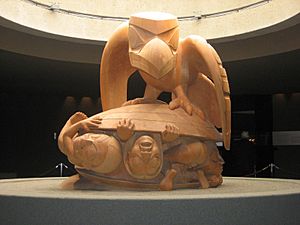
Across its range in the Northern Hemisphere, and throughout human history, the common raven has been a powerful symbol and a popular subject of mythology and folklore.
In some Western traditions, ravens have long been considered to be birds of ill omen, death and evil in general, in part because of the negative symbolism of their all-black plumage and the eating of carrion.
In Sweden, ravens are known as the ghosts of murdered people, and in Germany as the souls of the damned. In Danish folklore, valravne that ate a king's heart gained human knowledge, could perform great malicious acts, could lead people astray, had superhuman powers, and were "terrible animals".
As in traditional mythology and folklore, the common raven features frequently in more modern writings such as the works of William Shakespeare, and, perhaps most famously, in the poem "The Raven" by Edgar Allan Poe. Ravens have appeared in the works of Charles Dickens, J. R. R. Tolkien, Stephen King, George R. R. Martin and Joan Aiken among others.
It continues to be used as a symbol in areas where it once had mythological status: as the national bird of Bhutan (Kings of Bhutan wear the Raven Crown), official bird of the Yukon territory, and on the coat of arms of the Isle of Man (once a Viking colony).
In Persia and Arabia the raven was held as a bird of bad omen but a 14th-century Arabic work reports use of the raven in falconry.
Images for kids
-
A valkyrie speaks with a raven in a 19th-century illustration of the Old Norse poem Hrafnsmál ("raven song") by Frederick Sandys
See also
 In Spanish: Corvus corax para niños
In Spanish: Corvus corax para niños




